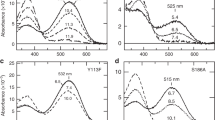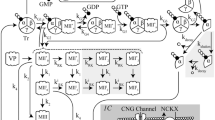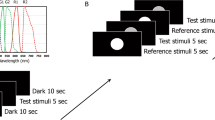Abstract
The only action of light on the pigment of cone vision, iodopsin, as on the rod pigment rhodopsin, is to isomerize its chromophore from 11-cis to all-trans. All further changes are “dark” consequences of this one light reaction. Although this reaction initiates bleaching, its immediate product is a more intense pigment. At low temperatures in the dark, this tends to revert to iodopsin rather than to bleach.
This is a preview of subscription content, access via your institution
Access options
Subscribe to this journal
Receive 51 print issues and online access
$199.00 per year
only $3.90 per issue
Buy this article
- Purchase on Springer Link
- Instant access to full article PDF
Prices may be subject to local taxes which are calculated during checkout
Similar content being viewed by others
References
Wald, G., Nature, 140, 545 (1937).
Wald, G., Brown, P. K., and Smith, P. H., J. Gen. Physiol., 38, 623 (1954–55).
Pigeon extracts: Brown, P. H., cited by Wald, G., in Visual Problems of Colour, Nat. Phys. Lab. U.K., Symp. No. 8, 19 (H.M.S.O., 1958). Bridges, C. B., Vision Res., 2, 125 (1962). Cone spectral sensitivities measured by Granit, R., Acta Physiol. Scand., frog, 3, 137 (1942); snake, 5, 108 (1943); cat, 5, 219 (1943). Green- and red-sensitive pigments of primate colour vision: Brown, P. K., and Wald, G., Nature, 200, 37 (1963).
Hubbard, R., and Kropf, A., Proc. U.S. Nat. Acad. Sci., 44, 130 (1958). Kropf, A., and Hubbard, R., Ann. N.Y. Acad. Sci., 74, 266 (1958).
Yoshizawa, T., and Kitô, Y., Nature, 182, 1604 (1958). Yoshizawa, T., Kitô, Y., and Ishigami, M., Biochim. Biophys. Acta, 43, 329 (1960). Kitô, Y., Ishigami, M., and Yoshizawa, T., Biochim. Biophys. Acta, 48, 287 (1961). Yoshizawa, T., Ann. Rep. Fac. Sci. Osaka Univ., 10, 1 (1962).
Grellmann, K.-H., Livingston, R., and Pratt, D., Nature, 193, 1258 (1962).
Matthews, R. G., Hubbard, R., Brown, P. K., and Wald, G., J. Gen. Physiol., 47, 215 (1963–64).
Hubbard, R., Bownds, D., and Yoshizawa, T., Cold Spr. Harb. Symp., 30, 301 (1965).
Yoshizawa, T., and Wald, G., Nature, 197, 1279 (1963).
Yoshizawa, T., and Wald, G., Nature, 201, 340 (1964).
Hubbard, R., and Kropf, A., Nature, 183, 448 (1959).
Keilin, D., and Hartree, E. F., Nature, 164, 254 (1949); Nature, 165, 504 (1950).
Yoshizawa, T., and Wald, G., Nature, 212, 483 (1966).
Hubbard, R., J. Gen. Physiol., 39, 935 (1955–56).
Hubbard, R., J. Amer. Chem. Soc., 78, 4662 (1956)—cites references to Zechmeister et al. which lead to the same conclusion.
Dartnall, H. J. A., Brit. Med. Bull., 9, 24 (1953).
Hubbard, R., J. Biol. Chem., 241, 1814 (1966). In free retinal the isomerization from all-trans to 11-cis involves a negligible heat change, but requires an activation energy of about 24 kcal/mole. For this reaction to go in the dark requires warming to about 80° C.
Author information
Authors and Affiliations
Rights and permissions
About this article
Cite this article
YOSHIZAWA, T., WALD, G. Photochemistry of Iodopsin. Nature 214, 566–571 (1967). https://doi.org/10.1038/214566a0
Received:
Revised:
Issue Date:
DOI: https://doi.org/10.1038/214566a0
This article is cited by
Comments
By submitting a comment you agree to abide by our Terms and Community Guidelines. If you find something abusive or that does not comply with our terms or guidelines please flag it as inappropriate.



